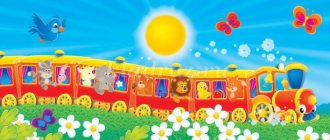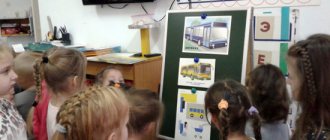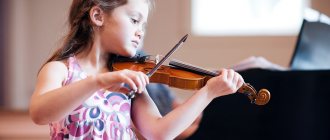Lesson summary for the middle group “Time, parts of the day”
Lesson summary for the middle group “Time, parts of the day”
Progress of the lesson
Children sit at tables, in front of them on an easel is a picture of Dunno and a toy, old Lesovik with a clock..
Educator: Guys, Dunno needs your help today. He went to visit the Guardian of Time, an old forest man, and could not answer a single question correctly. The dwarf wizard got angry and bewitched him. Can we help you disenchant Dunno? Shall we answer the Time Keeper's quests?
Children: Yes!
Educator: So, the first task is that a day consists of several parts, and each of them has its own name. Name and show the parts of the day.
Individual responses of children based on demonstration material.
Children: Morning, afternoon, evening, night.
Educator: How many are there in total?
Children: Four.
Educator: Well done, you completed the first task correctly. The second task is what in nature can tell us what part of the day has arrived? To complete this task we will use a diagram of the location of the Sun.
Children: - Morning, because the Sun is rising.
— Day, since the Sun is high in the sky.
- Evening, the sun is setting.
— Night, stars and the Moon appear in the sky.
Educator: And you coped with this task too! Children, not only the Sun and celestial bodies help determine the part of the day, but also what a person does. Therefore, the third task of the gnome wizard will be the game “When does this happen?”
Questions for children: What does a person do in the morning? (Wakes up, washes, does exercises, has breakfast). During the day? (Works, has lunch, walks). In the evening? (Returns from work, has dinner, goes to bed). At night? (Sleeping). Answers are accepted - none are correct. And now, the Time Keeper tells me that it’s time to relax, but with benefit!
Outdoor game "Geometric jumping rope"
(Two speed teams jump only on given geometric shapes laid out on the floor in the form of a chain). We played and sat down at the tables.
Educator: The next task game is called “Finish the sentence”:
— We have breakfast in the morning, and in the evening we .... (have dinner).
- We sleep at night, and in the morning... (we wake up).
- We play during the day, and at night... (sleep).
— The sun shines during the day, and the Moon ... (at night).
Well done, you did it! And the last task of the Time Keeper: two teams receive cards depicting parts of the day and collect a circle of parts of the day at speed, observing the strict order of their sequence, one after another.
Children in two teams at tables assemble a circle of parts of the day from cut-out pictures.
Educator: Well done to both teams, you completed all the tasks! The Time Keeper is ready to cast a spell on Dunno! Close your eyes!
The children close their eyes, the teacher removes the picture with the image of Dunno and takes out the Dunno doll.
Educator: Open your eyes! Here is Dunno, he thanks you for your help and good knowledge. And in parting I would like to wish you:
Morning afternoon Evening Night
They ran away for a day.
So as not to regret a day,
We need to take care of every hour!
Save time and knowledge! Goodbye!
Application:
Walks and quiet time
These important components of the daycare routine are also age-appropriate.
Children from the early age group go for a walk earlier than others, at 9.00-9.30. The quiet hour has also been increased - babies sleep on average from 12.30 to 15.00.
Children from the senior group and the preparatory group go to a quiet hour at 13.00; their sleep lasts an average of 1.5 hours. They also have a shorter time to prepare for a walk - children at this age can already independently and quickly change clothes for playing in the fresh air.
However, regardless of age, quiet time in kindergartens ends at 15.00. After afternoon tea, the younger groups have a general education lesson; students from the middle and older groups are engaged in games or independent activities.
During the second walk, the children are gradually picked up by their parents. In winter, due to the fact that it gets dark quite early, the time for the second walk is reduced, and children are taken directly from kindergarten. Also, the walk may be shortened due to weather conditions: for example, frost or strong wind.
Features of organizing work in classes in the senior group
Features of organizing work in classes in the senior group
In the older group, the duration of the lesson changes slightly compared to the average (from 20 to 25 minutes), but the volume and pace of work increase noticeably. Learning new things begins with repetition of material, which allows you to introduce new knowledge into the system of previously acquired ones. Repetition is often organized in the form of game exercises, problem solving (“Find Dunno’s mistake,” “Who is bigger?”) and takes from 1 to 5 minutes. Classes dedicated to consolidating knowledge also begin with game exercises. By stimulating the manifestation of ingenuity and ingenuity, these exercises allow children to focus their attention, activate their thinking, and create a good emotional mood. To consolidate knowledge, game exercises and didactic games are also carried out at the end of the lesson. In the senior group, combined exercises are widely used, allowing 2-3 tasks to be solved simultaneously. At the same time, work can be done on material from different sections of the program. In children aged 5 years, attention stability increases. However, they cannot perform monotonous work for a long time or maintain the same posture and need frequent changes of activities and motor relaxation. The teacher alternates work that requires voluntary attention with elements of the game. The number of similar exercises is limited to 3-4. Tasks related to performing movements are included. If there are no such tasks, then at the 12-14th minute a physical training minute is carried out. Whenever possible, its content is linked to the work in the classroom. The teacher tries to call as many children as possible to complete short tasks at his desk, flannelograph, on a typesetting canvas (add, remove an object, make pairs of objects, etc.). Visual, verbal and practical teaching methods and techniques in classes for the development of elementary mathematical concepts are mainly used in combination. Situations arise when existing knowledge is not enough to find the answer to the question posed, and a need arises to learn something new, to learn something new. For example, a teacher asks: “How can you find out how much longer the table is than its width?” The application technique known to children cannot be used. The teacher shows them a new way to compare lengths using a measuring stick. The incentive to search is suggestions to solve some kind of game or practical problem (pick a pair, make a rectangle equal to a given one, find out which objects are more, etc.). By organizing children’s independent work with handouts, the teacher also sets tasks for them (to check, learn, learn new things, etc.). Consolidation and clarification of knowledge and methods of action in a number of cases is carried out by offering children tasks, the content of which reflects situations that are close and understandable to them. So, they find out how long the laces of boots and low shoes are, select a watch strap that is suitable in width, etc. Children’s interest in solving such problems ensures active work and solid assimilation of knowledge. Mathematical concepts “equal”, “not equal”, “more - less”, “whole and part”, etc. are formed on the basis of comparison. Children 5 years old can already, under the guidance of a teacher, sequentially examine objects, identify and compare their homogeneous features. Based on comparison, children identify significant relationships, for example, relationships of equality and inequality, sequence, whole and part, etc., and make simple conclusions. The development of mental activity operations (analysis, synthesis, comparison, generalization) in the senior group is given great attention. Children perform all these operations based on clarity. The active inclusion of various analyzers in the work of children continues to be of great importance in the education of 5-year-old children. Consideration, analysis and comparison of objects when solving problems of the same type are carried out in a certain sequence. For example, children are taught to consistently analyze and describe a pattern made up of models of geometric shapes. Gradually they master the general method of solving problems of this category and consciously use it. In the older group, the types of visual aids are expanded and their nature is somewhat changed. Toys and things continue to be used as illustrative material. But now a big place is occupied by working with pictures, color and silhouette images of objects, and the drawings can be schematic. For example, the days of the week are conventionally indicated by multi-colored chips or numerical figures. This helps children establish ordinal relationships between the days of the week and remember their sequence. In working with children aged 5-6 years, the role of verbal teaching methods increases. The teacher’s instructions and explanations guide and plan the children’s activities. When giving instructions, he takes into account what the children know and can do, and only shows new methods of work. The teacher’s questions during the explanation stimulate children to show independence and intelligence, encouraging them to look for different ways to solve the same problem: “How else can you do it? Check? Say?" Children are taught to find different formulations to characterize the same mathematical connections and relationships. It is essential to practice new methods of action in speech. Therefore, while working with handouts, the teacher asks first one or the other child what, how and why he is doing. One child can do the task at the board at this time and explain his actions. Accompanying an action with speech allows children to comprehend it. After completing any task there is a survey. Children report on what and how they did and what happened as a result. Mistakes made by children are always corrected through actions with didactic material. As the child accumulates the ability to perform certain actions, you can first suggest what should be done and how (build a series of objects, group them, etc.), and then perform a practical action. This is how children are taught to plan the ways and order of completing a task. In the older group, they begin to use verbal games and game exercises, which are based on presentation actions: “Say the opposite!”, “Who can name it faster?”, “Which is longer (shorter)?” Increasing complexity and variation in work methods, changing aids and situations stimulate children to show independence and activate their thinking. To maintain interest in classes, the teacher constantly introduces elements of games (search, guessing) and competition, the opportunity to win: “Who can find (bring, etc.) faster.” When explaining to five-year-old children how to behave in class, they rely on their consciousness. The teacher constantly emphasizes that those who listen attentively to him and their comrades, work without distraction, and are always ready to answer questions, remember well and complete tasks correctly. Showing the dependence of the result of the work on how the children listened to and remembered the task teaches them to appreciate the teacher’s instructions and act exactly in accordance with them. The ability to manage their attention in 5-year-old children is just beginning to develop. Therefore, it is necessary to encourage them to be attentive. The teacher approves of those who try, work with concentration, keep up with their comrades and complete the task. When summing up the results of the lesson, they evaluate not only how the material was learned, but also the behavior of the children in the lesson. In the older group, children are often given tasks that, along with solving an educational task, train voluntary attention and memory, for example, game exercises “What has changed?”, “Silent”, etc. Much attention is paid to the development of self-control. The main means of developing self-control is the teacher’s assessment of the actions and results of children’s work. After listening to the child’s report on completing the task, he gives an assessment, helps to find the causes of errors and correct them. In some cases, children are asked to exchange work and check whether a friend has completed the task correctly. Self-control is fostered by presenting a sample after completing a task. Checking whether he did it as shown in the example, the child finds and corrects mistakes. Children are taught to fairly evaluate the results of their work and the work of their comrades. Controlling their own actions during work makes it difficult for five-year-old children, therefore, first they are taught to control each other’s work, for example, to monitor the actions of a friend working at the teacher’s desk (at the blackboard), to evaluate not only the result, but also the way the task is completed. Children are taught to listen carefully to a friend’s answer, not to repeat, but to supplement and clarify it. (“Have you said everything? Is it clear?”) They organize work in pairs, when one child completes the task and the other controls it. Evaluating the teacher and monitoring the actions of a friend allow children to further master the ability to control their own activities. In the older group, they continue to develop skills of organized behavior in class; children are taught to be restrained, to raise their hand only when they know how to answer a question, to wait patiently when called, to prepare their workplace, and to keep their manuals in order throughout the entire class. A large number of aids are used in mathematics classes, so it is important to provide for the order in which they are placed. When preparing for a lesson, it is advisable to arrange the manuals in such an order that those that will be needed first are at the top, and those at the bottom are the last. At first, they are placed on the table to the left of the child, and as work progresses, he puts the used aids to his right. Children now take small counting material from a common tray. In each specific case, the teacher determines what those on duty in the lesson should do and what each of the children should do. This also applies to organizing the workplace and cleaning up supplies after class.
Features of organizing mathematics classes in the senior group of kindergarten
Approximate daily routine for a preschooler
7.00-8.30 - Reception of children 8.10 - Exercise 8.30 - Breakfast 9.00-10.00 - Classes 10.30-11.30 - Walk 12.00 - Lunch 12.30-15.00 - Day nap 15.30 - Afternoon snack 16.00-17.00 - Classes 17.00 - Pro party 18:00 - Dinner 19.00 - Care children home
As can be seen from the schedule, according to the recommendations of SanPiN, a kindergarten pupil is provided with four meals a day, with an interval of 4 hours between meals, there are also two walks, one of which is in the afternoon (the time of which may be reduced due to weather conditions), in addition, it is mandatory nap, and of course there is time for activities and games.
It is worth noting that there are slight differences in the daily routine of each group in kindergarten, which take into account the age characteristics of the children.
For example, if the duration of classes in the junior group of a kindergarten is only 10 minutes, then preschoolers of the senior and preparatory groups study for 20-30 minutes, which is close to school classes. The same applies to preparatory moments and getting ready - older children need less time to get dressed for a walk, or wash their hands before lunch.
Next, we will look at several important points from the daily routine in kindergarten in more detail.
Games, joint and independent activities
Games and shared activities are very important for children. They teach children to communicate, develop creative thinking and imagination. During joint classes, a group of children completes tasks proposed by the teacher, thus preschoolers learn to work in a team and develop communication skills.
A total of three hours are allotted for independent games and activities, which allows the child to devote time to his own interests. Children play during the remaining time in such a tight schedule: before morning exercises, before and after classes, during walks.




